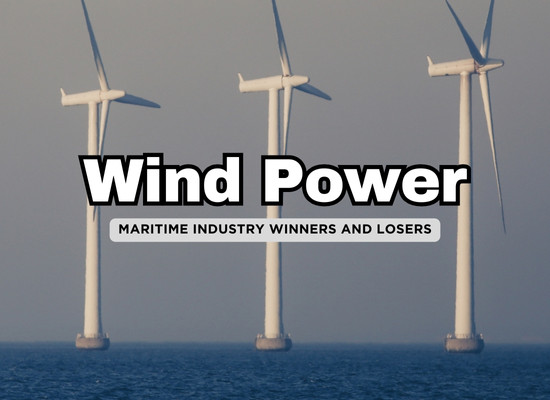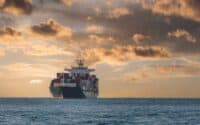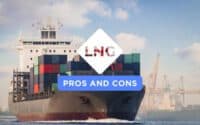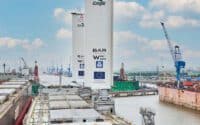Offshore Wind Energy in 2025: Trends, Challenges, and Maritime Impacts

Offshore wind energy is taking the world by storm, with huge investments, new technologies, and game-changing opportunities emerging across the globe. As massive wind farms rise offshore, maritime shipping is feeling the ripple effects—from altered shipping routes and new vessel demands to economic shifts in coastal communities. In this article, we dive into the impact of offshore wind on the maritime industry, explore the winners and losers of this shift, and look at the growth trends shaping the future.
** We welcome your feedback, suggestions, corrections, and ideas for enhancements. Please email editor at shipuniverse.com **
🧮 Article Contains ShipUniverse Maritime Calculators
| ShipUniverse: Global Energy Transition Impact Calculator | |
|---|---|
| Enter Global Energy Demand (TWh) | |
| Percentage to Replace with Offshore Wind | % |
| Energy Replaced by Offshore Wind (TWh) | - |
| CO₂ Reduction (Million Tons) | - |
| Estimated Cost Savings (Billion $) | - |
1️⃣ Offshore Wind World Sentiment
Offshore wind energy is shaping the future of global power generation, but not all countries are moving at the same pace. While some nations are doubling down on ambitious expansion plans, others are facing regulatory hurdles, economic slowdowns, or opposition to large-scale projects.
In this 2025 Offshore Wind Sentiment Tracker, we break down the latest developments in the top 20 offshore wind energy players. Are they pushing forward with new investments, hitting roadblocks, or staying neutral? Check out the table below to see where each country stands and what’s shaping their offshore wind future.
** This data is fluid. If you represent a local government in this table and would like to offer additional insights please email editor at shipuniverse.com **
| ShipUniverse: Offshore Wind Energy Sentiment by Country | ||
|---|---|---|
| Country | Sentiment | Summary |
| China 🇨🇳 | 🟢 Positive | China continues to lead in offshore wind energy expansion, with significant investments and projects underway to further increase capacity. The nation is actively enhancing its offshore wind infrastructure to meet growing energy demands and environmental goals. |
| United Kingdom 🇬🇧 | 🟢 Positive | The UK is advancing its offshore wind energy sector, with plans to quadruple capacity by 2030. Recent approvals for subsea interconnector projects aim to enhance grid flexibility and integrate renewable energy sources, reinforcing the UK's commitment to a clean energy future. |
| Germany 🇩🇪 | ⚪ Neutral | Germany has ambitious offshore wind energy targets but faces challenges in infrastructure expansion and project implementation. Industry leaders are calling for improved conditions, increased workforce, and robust industrial policies to meet the government's goals. |
| Netherlands 🇳🇱 | 🟢 Positive | The Netherlands is actively expanding its offshore wind capacity, with significant projects underway. Collaborative efforts with neighboring countries aim to harness the North Sea's potential, contributing to Europe's renewable energy targets. |
| Denmark 🇩🇰 | 🟢 Positive | Denmark continues to lead in offshore wind energy, with innovative projects like energy islands in the North Sea. These initiatives aim to significantly boost capacity and position Denmark as a central hub in Europe's green energy transition. |
| Belgium 🇧🇪 | 🟢 Positive | Belgium is advancing its offshore wind energy sector, with recent tenders aiming to add 700 MW in the North Sea. The government is committed to expanding renewable energy capacity to meet climate goals. |
| France 🇫🇷 | 🟢 Positive | France is accelerating its offshore wind initiatives, with multiple projects underway. The government has launched tenders aiming to add significant capacity, reinforcing its commitment to renewable energy expansion. |
| Taiwan 🇹🇼 | 🟢 Positive | Taiwan is actively expanding its offshore wind capacity, with projects like the 500 MW Fengmiao offshore wind farm involving international collaborations. The government aims to install 5.7 GW by 2025, with plans for an additional 15 GW by 2035. |
| Vietnam 🇻🇳 | ⚪ Neutral | Vietnam has ambitious offshore wind energy plans but faces challenges due to rising costs and regulatory uncertainties. While projects are in development, the industry is navigating economic and infrastructural hurdles. |
| Japan 🇯🇵 | 🟢 Positive | Japan is progressing in offshore wind energy, with significant projects like the 615 MW development off Aomori Prefecture. Despite some financial setbacks, the nation remains committed to expanding its offshore wind capacity to meet decarbonization goals. |
| Sweden 🇸🇪 | 🔴 Negative | In November 2024, Sweden rejected plans for 13 offshore wind farms in the Baltic Sea, citing national security concerns. The government expressed that the turbines could impede radar systems, potentially slowing response times to missile attacks. This decision reflects a cautious approach to offshore wind development due to defense priorities. |
| South Korea 🇰🇷 | 🟢 Positive | South Korea is emerging as a significant player in the offshore wind sector, with plans to expand its capacity substantially. The government has initiated grid allocation auctions, with offshore wind expected to feature prominently, reflecting a strong commitment to renewable energy expansion. |
| Norway 🇳🇴 | 🟢 Positive | Norway is advancing its offshore wind initiatives, with a 1.5-GW floating wind tender scheduled for 2025. Despite some changes in partnerships, companies like Statkraft are actively assessing options to participate, indicating a positive trajectory in the country's offshore wind development. |
| Finland 🇫🇮 | 🟢 Positive | Finland is set to open an offshore wind tender by the end of 2025, aiming to develop wind power areas in its exclusive economic zone. This initiative underscores Finland's commitment to expanding its renewable energy portfolio through offshore wind projects. |
| United States 🇺🇸 | 🔴 Negative | The U.S. offshore wind industry faces significant challenges following President Trump's executive order halting new federal offshore wind leases. This policy shift has led to project delays and financial setbacks, exemplified by Ørsted's $1.7 billion impairment on its U.S. projects. The future of offshore wind development in the U.S. remains uncertain under the current administration. |
| Italy 🇮🇹 | 🟢 Positive | Italy is actively pursuing offshore wind energy to reduce reliance on fossil fuels and enhance energy security. The government is committed to developing offshore wind as part of its renewable energy strategy, with several projects in the planning stages. |
| Ireland 🇮🇪 | 🟢 Positive | Ireland is advancing its offshore wind sector, with the Sceirde Rock wind farm progressing towards construction. This 450 MW project aims to power approximately 295,000 homes by 2030, reflecting Ireland's commitment to expanding its renewable energy infrastructure. |
| Portugal 🇵🇹 | 🟢 Positive | Portugal is accelerating its offshore wind initiatives, aiming to establish a cluster of wind farms with a potential capacity of up to 10 GW. The government plans to hold its first offshore license auction this year, marking a significant step in its renewable energy expansion. |
| Spain 🇪🇸 | 🟢 Positive | Spain is experiencing a renewable energy boom, with significant investments in wind and solar projects. In 2024, renewables accounted for 56% of all electricity production, underscoring Spain's leadership in the energy transition. |
| Poland 🇵🇱 | 🟢 Positive | Poland is making substantial strides in offshore wind energy, with the 1.5 GW Baltica 2 Offshore Wind Farm reaching its final investment decision. This project, expected to be fully operational by 2027, signifies Poland's commitment to diversifying its energy mix and enhancing energy security. |
2️⃣ Growth Trends: 2025 Outlook
The offshore wind energy sector is experiencing unprecedented growth as nations worldwide invest heavily in renewable energy to combat climate change and enhance energy security. Projections for 2025 indicate significant expansions in installed capacities, driven by technological advancements, favorable policies, and substantial financial commitments.
Below is a detailed overview of the projected offshore wind capacities for key regions and countries by 2025:
| ShipUniverse: Offshore Wind Energy Growth Trends (2025) | |||
|---|---|---|---|
| Growth Factor | Current Impact | Projected Growth | Key Takeaways |
| Global Installed Capacity | ~80 GW (as of 2024) | Expected to reach 220 GW by 2030 | Offshore wind is scaling rapidly, with China, Europe, and the U.S. leading new installations. |
| Floating Wind Technology | Still in pilot stages, with a few commercial-scale projects | Could unlock 80% of offshore wind potential by 2035 | Floating wind farms enable deeper-water installations, opening new markets like the U.S. West Coast and Japan. |
| Investment & Financing | Strong but challenged by rising costs and supply chain issues | $1 trillion in offshore wind investment expected by 2040 | Despite economic challenges, offshore wind remains a key investment priority for governments and energy firms. |
| Government Policies & Subsidies | Aggressive targets in EU, U.S., and Asia | New tax credits & grants driving expansion | Supportive policies will determine how quickly offshore wind can compete with fossil fuels. |
| Offshore Wind Turbine Size | Most turbines range from 8-12 MW | 20+ MW turbines expected by 2030 | Larger turbines reduce costs and increase efficiency, but require infrastructure upgrades. |
| Environmental & Grid Integration | Grid congestion and ecological concerns slowing projects | Solutions like energy storage and interconnectors expanding | Integrating offshore wind efficiently remains a major hurdle in many regions. |
3️⃣ Supporters and Opponents
Offshore wind energy has become a major battleground in the global shift to renewable energy. While some nations and industries are all-in, citing economic and environmental benefits, others are pushing back, raising concerns over costs, marine ecosystems, and aesthetic impacts.
This divide is shaping the future of offshore wind, influencing policies, investments, and public perception. Below, we break down the top five arguments in support of offshore wind and the top five arguments against it, based on 2025 developments.
| ShipUniverse: The Case For and Against Offshore Wind Energy | ||
|---|---|---|
| Argument | Position | Summary |
| 1. Massive Renewable Energy Potential | 🟢 Support | Offshore wind has the potential to generate more energy than the world currently consumes. With floating wind technology advancing, new deep-water areas are opening up, increasing offshore wind's role in global energy security. |
| 2. Creates Jobs and Economic Growth | 🟢 Support | The offshore wind industry is projected to support over 3 million jobs globally by 2030. From turbine manufacturing to port upgrades and installation, the economic benefits extend across multiple industries. |
| 3. Reduces Dependence on Fossil Fuels | 🟢 Support | Many countries see offshore wind as a way to reduce reliance on imported fossil fuels. By harnessing local wind resources, nations can enhance energy security and stabilize energy prices. |
| 4. Complements Other Renewables | 🟢 Support | Unlike solar energy, which peaks during the day, offshore wind often generates power at night, making it an ideal complement to solar and other renewables in a balanced energy grid. |
| 5. Advances in Floating Wind Technology | 🟢 Support | The rise of floating wind farms allows for offshore wind development in deeper waters, expanding its potential and reducing conflicts with shipping lanes and fisheries. |
| 1. High Upfront Costs | 🔴 Opposition | Offshore wind farms require massive capital investments, with installation and maintenance costs significantly higher than onshore wind or solar. Some projects are delayed due to financing challenges. |
| 2. Environmental Concerns | 🔴 Opposition | There is growing concern over the impact of offshore wind farms on marine ecosystems. Critics argue that construction noise, electromagnetic fields, and habitat disturbances harm sea life. |
| 3. Impact on Fisheries | 🔴 Opposition | Fishermen in various countries are protesting offshore wind developments, citing restricted access to traditional fishing areas and potential negative effects on fish populations. |
| 4. Grid Connection Challenges | 🔴 Opposition | Many regions lack the grid infrastructure to handle the variability of offshore wind power. Upgrading transmission networks requires additional investment and planning. |
| 5. Visual and Noise Pollution | 🔴 Opposition | Coastal communities and tourism industries oppose offshore wind farms due to concerns about spoiled ocean views and low-frequency noise from turbines affecting local residents. |
4️⃣ Impact on Maritime Shipping
The offshore wind boom isn’t just reshaping energy markets—it’s transforming maritime shipping in ways few anticipated. As massive offshore wind farms rise along coastlines, shipping routes are shifting, ports are upgrading, and entirely new classes of vessels are emerging to support the industry.
For commercial shipping, offshore wind presents both opportunities and challenges. While new wind farm developments create navigation restrictions and rerouted shipping lanes, they also drive demand for high-tech service vessels, installation ships, and port infrastructure upgrades. The maritime sector is adapting to these changes, with fleet operators, shipbuilders, and port authorities playing a critical role in supporting the offshore wind revolution.
In the following table, we’ll break down how offshore wind energy is reshaping maritime logistics, which sectors are winning from the transition, and what new challenges lie ahead for global shipping.
| ShipUniverse: Offshore Wind's Impact on Maritime Shipping | ||
|---|---|---|
| Impact Area | Changes & Developments | Opportunities & Challenges |
| Shipping Routes & Navigation | Large offshore wind farms are altering established shipping lanes, requiring vessels to reroute around restricted zones. New regulatory measures are being introduced to ensure safe passage near offshore wind installations. | Opportunity: Ports and shipping companies are developing advanced navigation systems to optimize new routes. Challenge: Longer transit times and congestion near high-density wind farm regions. |
| Demand for Installation Vessels | The offshore wind boom has triggered a surge in demand for specialized installation ships, such as jack-up vessels and heavy-lift crane ships, which transport and erect massive wind turbines at sea. | Opportunity: Shipbuilders and investors are racing to develop next-gen wind turbine installation vessels to meet demand. Challenge: A shortage of available vessels is causing delays in wind farm construction. |
| Service Operation Vessels (SOVs) | With wind farms operating far offshore, SOVs equipped with dynamic positioning systems are essential for maintenance crews, ensuring long-term servicing of turbines. | Opportunity: The rise of offshore wind is fueling a lucrative market for SOVs with advanced automation and crew accommodations. Challenge: High build costs and limited shipyard capacity are slowing fleet expansion. |
| Port Infrastructure Upgrades | Ports are upgrading facilities to handle larger wind turbine components, with investments in deepwater berths, crane capacity, and expanded storage areas. | Opportunity: Ports catering to offshore wind logistics are seeing increased revenue and job creation. Challenge: Expanding port infrastructure requires long-term investment and careful urban planning. |
| Environmental & Safety Regulations | Governments and maritime authorities are introducing stricter guidelines to prevent collisions and ensure offshore wind farms do not disrupt marine ecosystems. | Opportunity: Increased regulation is driving innovation in vessel tracking, collision avoidance, and offshore wind farm security. Challenge: Compliance costs and regulatory uncertainty can slow industry growth. |
| Impact on Traditional Shipping | Some commercial shipping operators are raising concerns over wind farm expansion interfering with established trade routes, particularly near high-traffic coastal areas. | Opportunity: Collaboration between offshore wind developers and maritime industry leaders can create shared-use zones. Challenge: Resistance from shipping companies concerned about delays and increased fuel costs. |
5️⃣ Winners & Losers
The rapid expansion of offshore wind energy is creating massive opportunities for some industries while disrupting others. As billions flow into new wind farm projects, shipbuilders, port operators, and renewable energy firms are cashing in, while traditional fuel transporters, fisheries, and some coastal communities are feeling the squeeze.
For every new offshore wind installation, there’s a ripple effect across multiple sectors—some are thriving, others are struggling to adapt. The following table will break down who’s winning, who’s losing, and why, providing a clear picture of offshore wind’s economic impact in 2025.
| ShipUniverse: Winners & Losers in Offshore Wind Energy | ||
|---|---|---|
| Sector | Impact | Why It’s Winning or Losing |
| Shipbuilders & Maritime Engineering | 🟢 | The demand for offshore wind installation vessels, service operation vessels (SOVs), and crew transfer ships is skyrocketing. Shipyards that can deliver these specialized vessels are experiencing full order books. |
| Port Authorities & Logistics | 🟢 | Major ports are upgrading infrastructure to handle massive turbine components, boosting local economies and positioning themselves as offshore wind logistics hubs. |
| Renewable Energy Developers | 🟢 | Companies specializing in offshore wind farm development are securing multi-billion-dollar contracts, with governments prioritizing renewables over fossil fuels. |
| Coastal Manufacturing & Supply Chain | 🟢 | The need for turbine blades, foundations, cables, and electrical infrastructure is creating thousands of jobs in coastal manufacturing hubs. |
| Energy Storage & Grid Companies | 🟢 | With more offshore wind power feeding the grid, energy storage and transmission companies are expanding operations to ensure a stable supply. |
| Fossil Fuel Transport & Bunkering | 🔴 | As offshore wind takes over, demand for bunker fuel and fossil fuel transport is decreasing, causing financial strain on traditional shipping companies. |
| Fisheries & Coastal Communities | 🔴 | Fishing operations near offshore wind farms are being disrupted, with some fisheries reporting lower catches due to habitat changes. |
| Tourism & Waterfront Property Owners | 🔴 | Coastal communities reliant on tourism are pushing back against offshore wind farms, citing ruined ocean views and reduced visitor interest. |
| Traditional Shipowners | 🔴 | Shipping routes are being altered to avoid offshore wind farms, leading to longer transit times and increased operational costs. |
| Grid Operators Unprepared for Offshore Wind | 🔴 | Some regions lack the infrastructure to handle offshore wind’s intermittent power supply, leading to inefficiencies and lost energy potential. |
Offshore wind energy is no longer just a niche renewable—it's a global force reshaping industries from maritime shipping to energy production. The ripple effects are vast: shipping lanes are being redrawn, ports are upgrading, and specialized vessel demand is soaring. At the same time, traditional players like fossil fuel transporters and fisheries are feeling the pressure, caught between an evolving energy landscape and economic realities. Governments are making big bets on offshore wind, but challenges remain, from infrastructure bottlenecks to environmental concerns.
As we look ahead, the offshore wind revolution is still in its early days. The sector's success will depend on how well nations balance growth with sustainability, how quickly infrastructure can adapt, and whether industry leaders can collaborate instead of compete in high-traffic coastal waters. For shipowners, investors, and maritime professionals, the shift is undeniable—offshore wind is here to stay, and those who adapt will find themselves sailing ahead of the curve. 🚢💨

Do you have a Maritime Product or Service that may be of interest to Shipowners? Tell us about it here!
Do you have feedback or insights? Please reach out to editor @ shipuniverse.com



